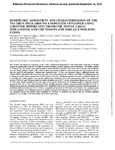
Please use this identifier to cite or link to this item:
http://ricaxcan.uaz.edu.mx/jspui/handle/20.500.11845/764Full metadata record
| DC Field | Value | Language |
|---|---|---|
| dc.contributor | 6207 | es_ES |
| dc.contributor.other | https://orcid.org/0000-0002-7081-9084 | es_ES |
| dc.coverage.spatial | Global | es_ES |
| dc.creator | Barros, Silvia | - |
| dc.creator | Gallego Díaz, Eduardo | - |
| dc.creator | Lorente, Alfredo | - |
| dc.creator | Goncalves, Isabel | - |
| dc.creator | Vaz, Pedro | - |
| dc.creator | Vega Carrillo, Héctor René | - |
| dc.date.accessioned | 2019-03-14T18:19:37Z | - |
| dc.date.available | 2019-03-14T18:19:37Z | - |
| dc.date.issued | 2012-12 | - |
| dc.identifier | info:eu-repo/semantics/publishedVersion | es_ES |
| dc.identifier.issn | 1742-3406 | es_ES |
| dc.identifier.issn | 0144-8420 | es_ES |
| dc.identifier.uri | http://localhost/xmlui/handle/20.500.11845/764 | - |
| dc.identifier.uri | https://doi.org/10.48779/dh8a-0j83 | es_ES |
| dc.description.abstract | The Neutron Measurements Laboratory at the Nuclear Engineering Department of the Polytechnic University of Madrid consists of a bunker-like room and was built for neutron dosimetry research purposes and measurements. The facility includes a 74-GBq 241Am–Be neutron source placed inside a neutron Howitzer container. The source can be moved to the irradiation or to the storage position. In this work, a Bonner sphere spectrometer (BSS) was used to measure the neutron fluence spectra with the source in both positions. Ambient dose equivalent rates, H *(10), were measured using a calibrated neutron area monitor LB6411 (Berthold). The measured count rates were used as input to the NSDann and NSDUAZ unfolding programs to obtain the neutron fluence spectra and H *(10). Monte Carlo (MC) simulation methods were used to model the system and to calculate the neutron fluence rate and the ambient dose equivalent rate at the measurement points. The comparison between NSDUAZ and NSDann resulted in relative deviations up to 6.87 % in the total neutron fluence rate and 7.18 % in H *(10) values, despite the differences in the shape of the spectra obtained for the irradiation position. Comparing with the measured values, the H *(10) values obtained with the unfolding programs exhibit a maximum relative deviation of 12.19 %. Taking into account the associated uncertainties, MC simulations seem to be in reasonable agreement with measurements. A maximum relative deviation of 15.65 % between computed and measured H *(10) values was obtained. The computed count rates were applied to the unfolding programs to calculate the total neutron fluence rate and a maximum deviation of 12.83 % was obtained between the original values calculated by NSDann. A sensitivity test showed that the NSDann unfolding program is very sensitive to the uncertainties of the BSS count rates. | es_ES |
| dc.language.iso | eng | es_ES |
| dc.publisher | Oxford Academic | es_ES |
| dc.relation.uri | generalPublic | es_ES |
| dc.rights | Atribución-NoComercial-CompartirIgual 3.0 Estados Unidos de América | * |
| dc.rights.uri | http://creativecommons.org/licenses/by-nc-sa/3.0/us/ | * |
| dc.source | Radiation Protection Dosimetry, Vol. 154, No 3, 2012, pp. 346-355 | es_ES |
| dc.subject.classification | CIENCIAS FISICO MATEMATICAS Y CIENCIAS DE LA TIERRA [1] | es_ES |
| dc.subject.other | neutron dosimetry research | es_ES |
| dc.subject.other | Bonner sphere spectrometer (BSS) | es_ES |
| dc.subject.other | neutron fluence spectra | es_ES |
| dc.title | Dosimetric assessment and characterisation of the neutron field around a Howitzer container using a bonner sphere spectometrer, Monte Carlo simulations and the NSDANN and NSDUAZ unfolding codes | es_ES |
| dc.type | info:eu-repo/semantics/article | es_ES |
| Appears in Collections: | *Documentos Académicos*-- UA Ciencias Nucleares | |
This item is licensed under a Creative Commons License

